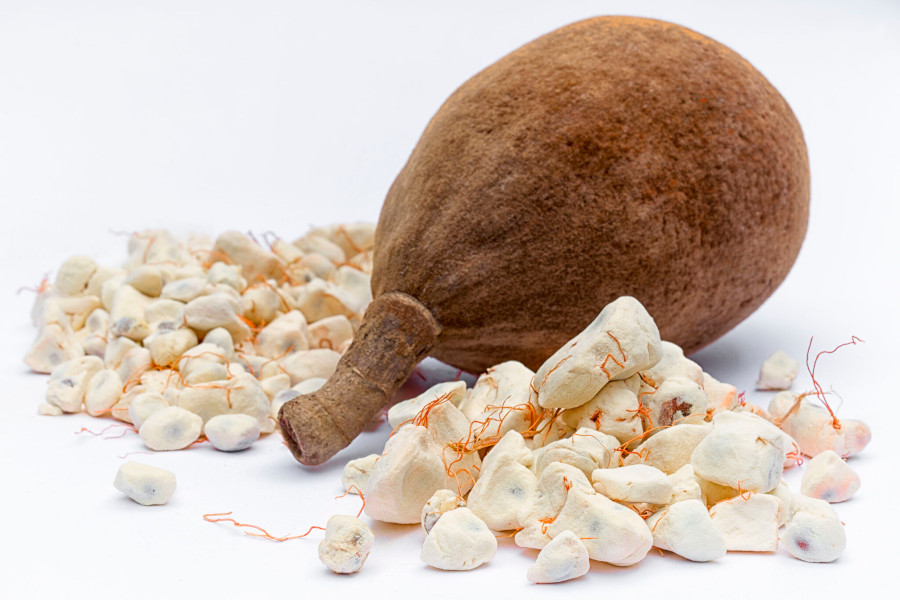Africa is a continent renowned for its rich biodiversity, and its array of indigenous fruits is a testament to this natural wealth. From the iconic baobab, often referred to as the “Tree of Life,” to the lesser-known treasures like the Ethiopian banana, Africa boasts a diverse tapestry of fruits that have sustained communities for generations. In this article, we delve into the vibrant world of African fruits, exploring their flavours, uses, and cultural significance.
Here’s a list of fruits that are native or indigenous to Africa:
1. Baobab Fruit (Adansonia digitata): The fruit of the baobab tree has a powdery pulp that is rich in vitamin C and antioxidants. It has a tangy flavour and is used in beverages, jams, and sauces. Boabab is known as the “Tree of Life,” baobab produces a fruit with a tart flavour. It’s also often as a nutritional supplement.
2. Marula (Sclerocarya birrea): This fruit is popular for its use in the production of a creamy liqueur. It has a sweet, tart flavour and is rich in ‘vitamin C’.
3. Mango: Mango trees are native to South Asia but have been cultivated in Africa for centuries. The continent is home to various indigenous varieties with unique flavours and characteristics.
4. Guava: While guava originated in Central America, it’s widely grown in Africa, especially in tropical regions. African guava varieties often have a distinct flavour.
5. Papaya (Pawpaw): Papaya is native to southern Mexico and Central America but is also cultivated in many African countries. It’s known for its sweet, orange flesh and ‘digestive enzymes’.
6. African Star Apple (Agbalumo/Udara): This fruit is native to West Africa and has a unique tangy-sweet flavour. It’s often enjoyed fresh or used in traditional dishes.
7. African Cherry (Agbalumo/Udara): Also known as the African cherry, this fruit is native to West Africa and has a sweet and tangy flavour. It’s commonly eaten fresh or used in jams and desserts.
8. Tamarind: Tamarind trees are native to tropical Africa and produce pods with a tangy pulp. The pulp is used in cooking, beverages, and sauces.
9. African Plum (Safou/Dacryodes edulis): Native to Central Africa, the African plum has a creamy texture and is often used in savoury dishes.
10. Monkey Orange (Strychnos spinosa): Found in various parts of Africa, the monkey orange has a citrusy flavour and is used in jams and beverages.
11. African Custard Apple (Annona senegalensis): This fruit is native to Africa and has a custard-like texture with a sweet flavour.
12. Mango Plum (Ximenia caffra): Native to southern Africa, the mango plum has a tart flavour and is used in jams and preserves.
13. African Horned Cucumber (Cucumis metuliferus): Also known as kiwano or melano, this fruit is native to Africa and has a jelly-like interior with a mildly sweet flavour.
14. African Cherry Orange (Citropsis articulata): Also known as the African cherry orange or finger citron, this fruit is native to Africa. It has a citrusy flavour and is used in cooking and traditional medicine.
15. African Pear (Dacryodes edulis): Native to West Africa, the African pear has a buttery texture and is often eaten fresh or used in cooking.
16. African Star Apple (Chrysophyllum albidum): This fruit is native to West Africa and has a sweet, juicy pulp. It’s commonly eaten fresh or used in desserts.
17. Black Velvet Tamarind (Dialium guineense): Native to West Africa, this fruit has a tangy-sweet flavour and is used in cooking and beverages.
18. Cape Gooseberry (Physalis peruviana): While not exclusively African, Cape gooseberry is grown in various regions of Africa. It has a sweet-tart flavour and is often used in jams and desserts.
19. Ethiopian Banana (Ensete ventricosum): Also known as false banana, this plant is native to Ethiopia. While not a true banana, its starchy fruits are used in cooking.
20. Finger Banana (Musa acuminata): Indigenous to Africa, finger bananas are smaller and sweeter than common bananas. They are often eaten fresh or used in cooking.
21. Guavaberry (Myrciaria floribunda): Native to Central and West Africa, guavaberry has a tart-sweet flavour and is used in beverages and preserves.
22. Horned Melon (Cucumis metuliferus): Also known as kiwano or African horned cucumber, this fruit is native to Africa. It has a jelly-like interior with a mildly sweet flavour.
23. Mabolo (Diospyros blancoi): Native to West Africa, mabolo has a sweet, custard-like flavour and is often used in desserts.
24. Soursop (Annona muricata): While not exclusively African, soursop is grown in various regions of Africa. It has a sweet and tangy flavour and is used in beverages and desserts.
In conclusion, the indigenous fruits of Africa not only contribute to the continent’s culinary heritage but also hold immense potential for economic development and nutritional enrichment. As global interest in exotic and nutritious foods continues to rise, these fruits offer a unique opportunity for Africa to showcase its agricultural prowess and foster sustainable livelihoods for its people. With careful preservation and promotion, Africa’s fruit diversity can flourish, providing a fruitful future for generations to come.
This article is copyrighted by Ital is Vital, 2025. Want to re-post this article? Visit our guidelines.
DISCLAIMER: THIS WEBSITE DOES NOT PROVIDE MEDICAL ADVICE
The information, including but not limited to, text, graphics, images and other material contained on this website are for informational purposes only. The purpose of this website is to promote broad consumer understanding and knowledge of various health topics. It is not intended to be a substitute for professional medical advice, diagnosis or treatment. Always seek the advice of your physician or other qualified health care provider with any questions you may have regarding a medical condition or treatment and before undertaking a new health care regimen, and never disregard professional medical advice or delay in seeking it because of something you have read on this website.
